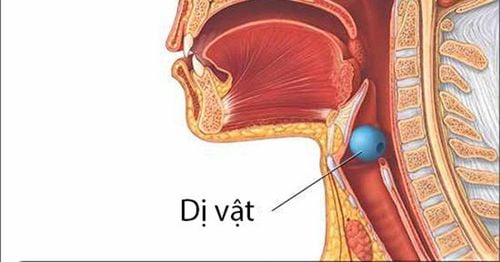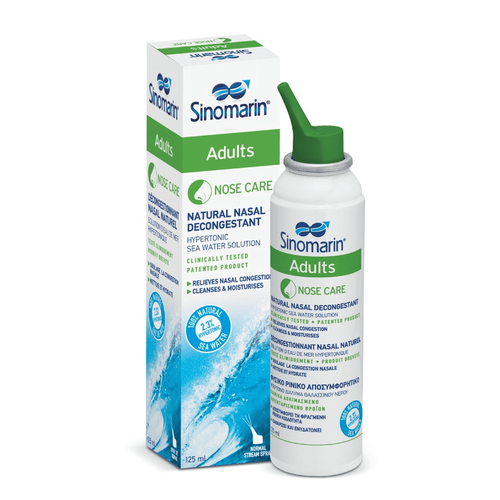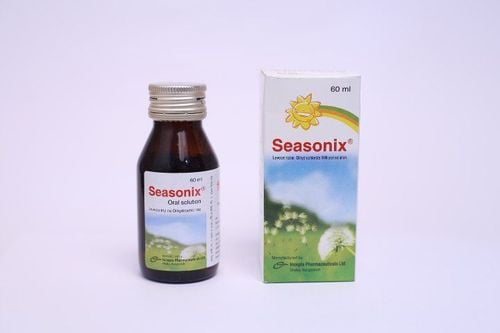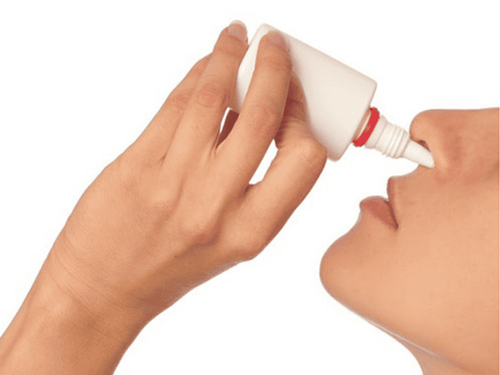This is an automatically translated article.
Articles of BS CKI. Le Van Quang - Ear, Nose Throat Doctor - General Surgery Department - Vinmec Nha Trang International Hospital
Drug-dependent rhinitis can be encountered in any subject when overusing decongestants. This condition can cause symptoms that affect the patient's quality of life. Drug-dependent rhinitis can be overcome with proper treatment.
1. Overview
Drug-dependent rhinitis (Rhinitis medicamentosa) is also known as recurrent nasal congestion. This is inflammation of the nasal mucosa due to overuse of topical decongestants and is a subgroup of drug-induced rhinitis in general. Topical decongestants are commonly used to relieve nasal congestion caused by allergic rhinitis, seasonal allergic rhinitis, acute or chronic sinusitis, nasal polyps, or upper respiratory tract infections.
Poor management and use of nasal decongestant/vasoconstrictor drugs increases the risk of developing drug-dependent rhinitis.
2. Pathological causes
The cause of this condition is mainly due to prolonged use of topical decongestants (more than 7 to 10 days). However, intranasal use of cocaine has also been reported to cause the same condition.
A complex set of nociceptive, parasympathetic and sympathetic nerves within the human nasal mucosa. They play a delicate role in coordinating the secretory activities of glands, blood vessels, and other processes. These functions are important for cleaning and humidifying the surrounding air before it is inhaled into the lungs. The surface of the nasal mucosa therefore contains many important receptors (receptors) such as adrenergic, cholinergic, muscarinic... that play a role in regulating physiological activities of the nose.
3. Physiological stuffy nose
The nasal mucosal vasculature can be divided into arterioles regulated mainly by alpha-2 adrenoreceptors, and cavernous vessels (venous plexus) regulated by both receptor alpha-1 and alpha-2. Stimulation of these receptors results in a vasoconstrictor/decongestant effect due to constriction of the venous sinus systems, resulting in decreased blood flow, reduced nasal edema and runny nose.
Contributing factors to nasal congestion include stimulation of the parasympathetic nervous system, the release of local mediators including mast cells, eosinophils, and basophils; then stimulates the release of histamine, tryptase, kinins, prostaglandins, and leukotrienes, causing an overall change in nasal resistance, along with plasma exudation through surface capillaries, and increased mucin production by the nasal passages. secretory cells.

Viêm mũi dị ứng thời tiết có thể xuất hiện nghẹt mũi
4. Topical decongestants
Topical decongestants can be classified as beta-phenylethylamine derivatives or imidazoline derivatives. Beta-phenylethylamine derivatives mimic the effects of sympathetic nervous system stimulation by inducing vasoconstriction through the activation of alpha-1 adrenoreceptors. Reversible vasodilation can occur due to weak affinity for beta-adrenorenore receptors. On the other hand, imidazolines exert their effects mainly through the alpha-2 adrenoreceptor receptor. This difference in adrenoreceptor sensitivity makes imidazoline more effective in reducing mucosal blood flow due to its vasoconstrictor effect on both impedance and ability to dilate blood vessels in the nasal mucosa. .
Similarly, the imidazole group exhibits stronger and longer lasting effects. For example, 0.1% xylometazoline hydrochloride works within minutes and lasts up to 10 hours, while 1% phenylephrine works within 15 to 20 minutes with effects lasting 2 to 4 hours.
4.1. Decongestants (adrenoreceptor activity) Beta-phenylethylamine derivatives Ephedrin HCl (alpha-1, alpha-2, beta-1, beta-2) Phenylephrin HCl (alpha-1) Imidazoline derivatives (mainstream) mainly alpha-2 agonist) Naphazoline HCl Oxymetazoline HCl Xylometazoline HCl
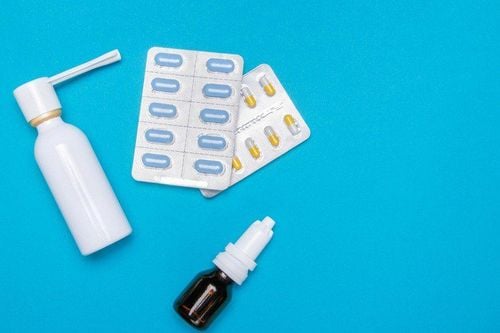
Các loại thuốc thông mũi trị viêm mũi cần được sử dụng theo đúng chỉ định của bác sĩ
4.2. Epidemiology Most common in young and middle-aged adults with similar prevalence in men and women. Incidence ranges from 1% to 9% in ENT clinics. The actual number may be higher as this drug is over-the-counter and reports may be flawed.
4.3. Pathophysiology Several hypotheses have been proposed, although the exact pathophysiology is unknown:
Hypothesis 1: Chronic vasoconstriction leads to ischemia of the nasal mucosa, which easily leads to edema. nasal interstitial tissue. Hypothesis 2: Overactivity of the constriction mechanisms occurs leading to a congestive and obstructive response; this then correlates with decreased sensitivity to endogenous catecholamines, adrenor-receptors becoming refractory to vasopressors, requiring higher drug doses (rapid anaphylaxis) Hypothesis 3: Altered motor tone Vasodilation leads to increased vascular permeability and edema Hypothesis 4: Beta-adrenoreceptor activity may outlast alpha action leading to regenerative vasodilatation 4.4. Symptoms on examination Patients mostly complain of recurrent nasal congestion but not rhinorrhea, and are related to prolonged use of decongestants. Severe nasal congestion can lead to mouth breathing, dry mouth, and snoring. Clinical examination will reveal swelling of the nasal mucosa, erythema and granulation, edema, or re-mucosal regurgitation. Easy to lead to nasal crusting and mucosal atrophy
Diagnosis of drug-dependent rhinitis relies heavily on history and clinical manifestations. Mainly, it is possible to evaluate other nasopharyngeal conditions that may be associated.
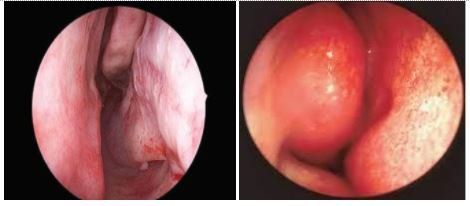
Viêm mũi trên hình ảnh nội soi mũi
4.5. Treatment Immediately stop using nasal vasoconstrictors Understand existing rhinitis conditions Use some other steroid nasal sprays, however all these preparations must be followed as directed by the Doctor in each case. case one. Some oral drugs such as anti-histamines, steroids, can also be prescribed depending on the patient's condition and response to treatment. The prognosis for recovery can last > 1 year in cases of drug use. long-term nasal pulse 4.6. Complications Chronic Sinusitis Atrophic rhinitis Perforated septum Hyperplasia/hypertrophy Drug-dependent rhinitis is a preventable condition. Therefore, awareness of the complications of drug abuse among healthcare professionals and patients is essential. Careful consideration and advice as well as adherence to treatment time between medical professionals and patients is a matter of concern for both sides.
Please dial HOTLINE for more information or register for an appointment HERE. Download MyVinmec app to make appointments faster and to manage your bookings easily.
References
Wallace DV, Dykewicz MS, Bernstein DI, Blessing-Moore J, Cox L, Khan DA, Lang DM, Nicklas RA, Oppenheimer J, Portnoy JM, Randolph CC, Schuller D, Spector SL, Tilles SA. , Joint Task Force on Practice. American Academy of Allergy. Asthma & Immunology. American College of Allergy. Asthma and Immunology. Joint Council of Allergy, Asthma and Immunology. The diagnosis and management of rhinitis: an updated practice parameter. J Allergy Clin Immunol. 2008 Aug;122(2 Suppl):S1-84. [PubMed] Ramey JT, Bailen E, Lockey RF. Rhinitis medicamentosa. J Investig Allergol Clin Immunol. 2006;16(3):148-55. [PubMed] Graf P, Hallén H. Effect on the nasal mucosa of long-term treatment with oxymetazoline, benzalkonium chloride, and placebo nasal sprays. Laryngoscope. 1996 May;106(5 Pet 1):605-9. [PubMed] Graf P, Hallen H, Juto JE. Benzalkonium chloride in a decongestant nasal spray aggravates rhinitis medicamentosa in healthy volunteers. Clin Exp Allergy. 1995 May;25(5):395-400. [PubMed] Graf P. Benzalkonium chloride as a precaution in nasal solutions: re-examining the data. Respir Med. 2001 Sep;95(9):728-33. [PubMed] Scadding GK. Adverse effects of benzalkonium chloride on the nasal mucosa: allergic rhinitis and rhinitis medicamentosa. Clin Ther. 2000 Jul;22(7):893-5. [PubMed] Marple B, Roland P, Benninger M. Safety review of benzalkonium chloride used as a precaution in intranasal solutions: an overview of conflicting data and opinions. Otolaryngol Head Neck Surg. 2004 Jan;130(1):131-41. [PubMed] Bernstein IL. Is the use of benzalkonium chloride as a precaution for nasal formulations a safety concern? A cautionary note based on compromised mucociliary transport. J Allergy Clin Immunol. 2000 Jan;105(1 Pet 1):39-44. [PubMed] Lockey RF. Rhinitis medicamentosa and the stuffy nose. J Allergy Clin Immunol. 2006 Nov;118(5):1017-8. [PubMed] Mortuaire G, de Gabory L, François M, Massé G, Bloch F, Brion N, Jankowski R, Serrano E. Rebound congestion and rhinitis medicamentosa: nasal decongestants in clinical practice. Critical review of the literature by a medical panel. Eur Ann Otorhinolaryngol Head Neck Dis. 2013 Jun;130(3):137-44. [PubMed]




